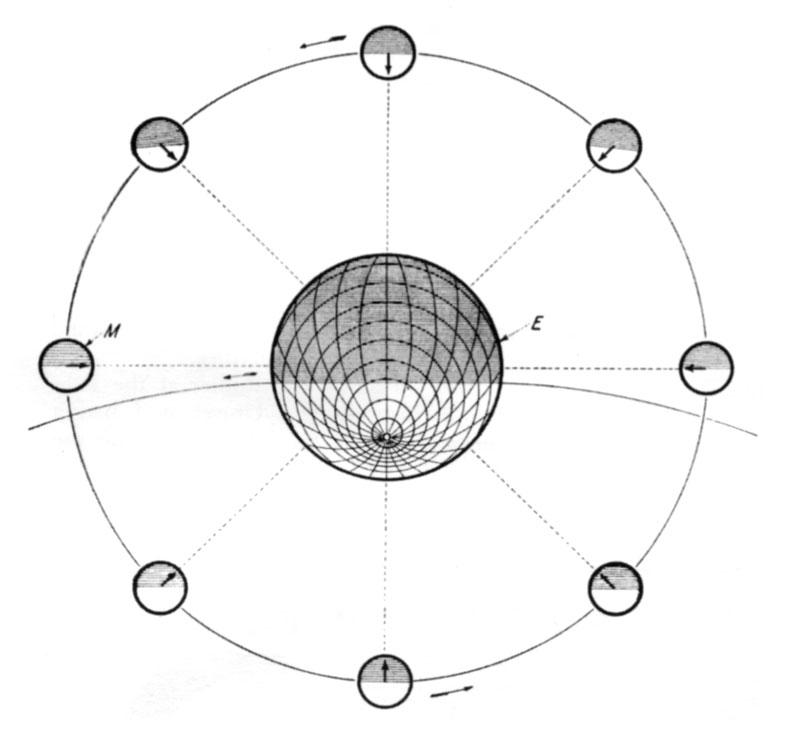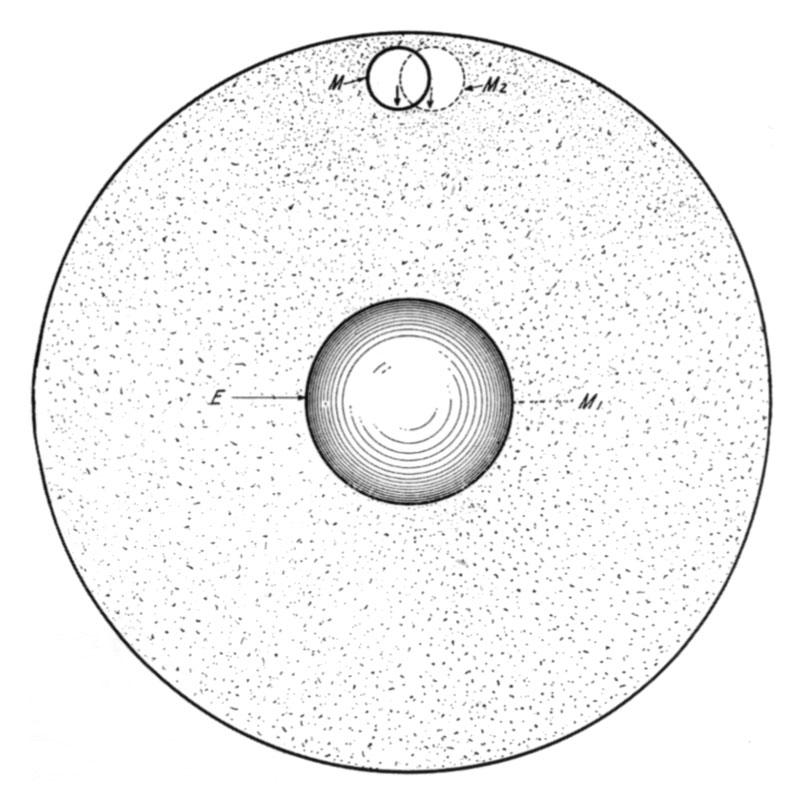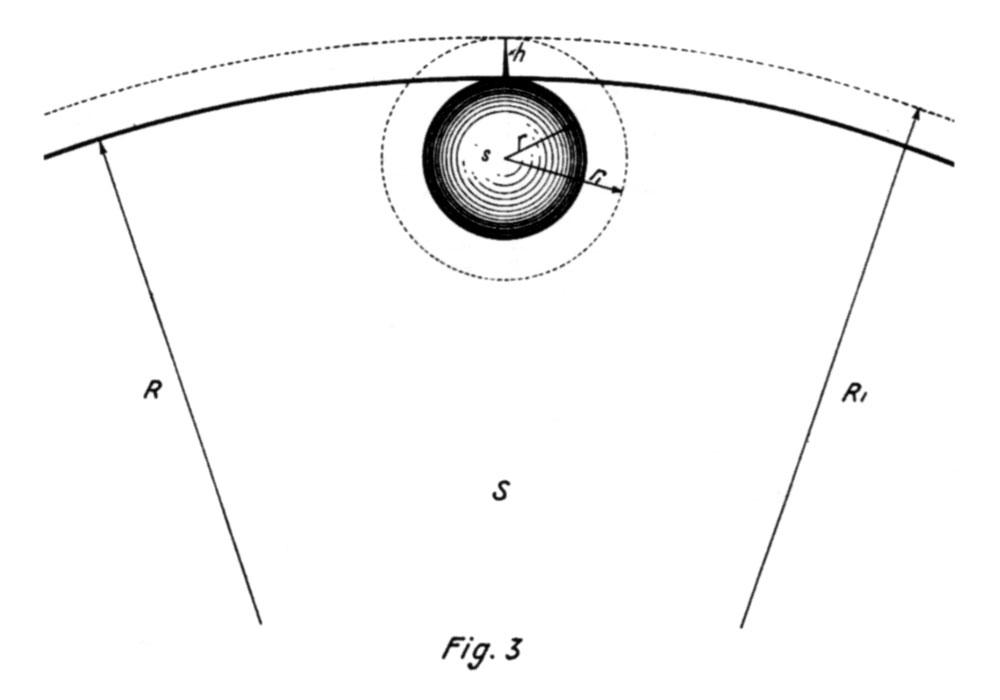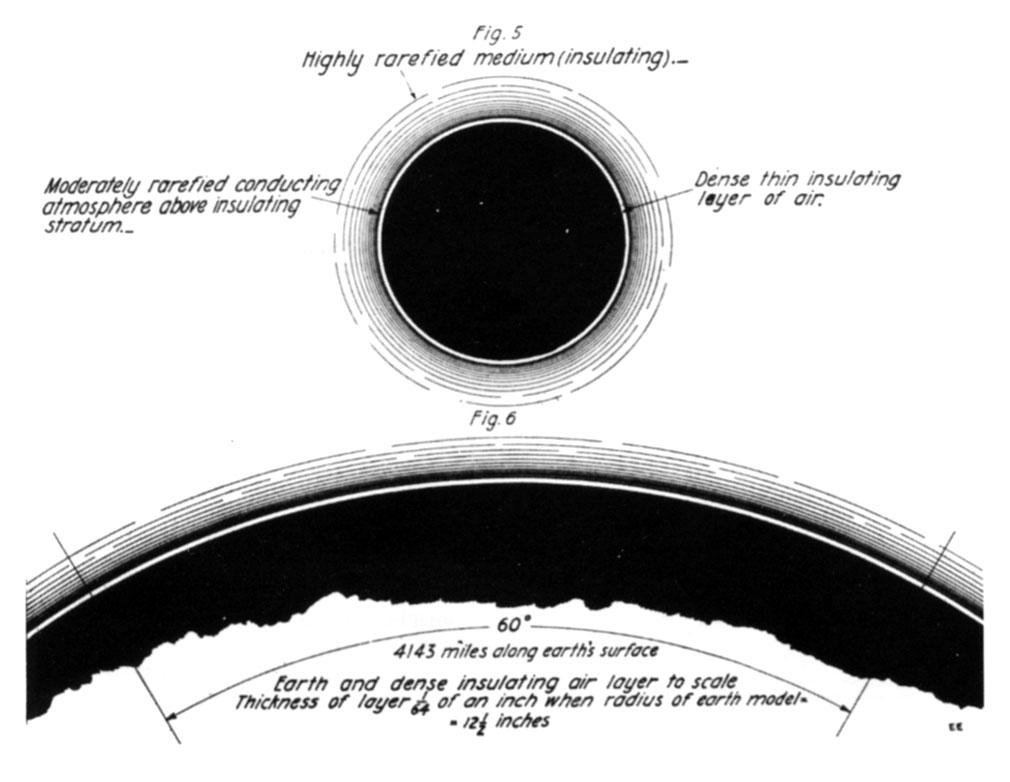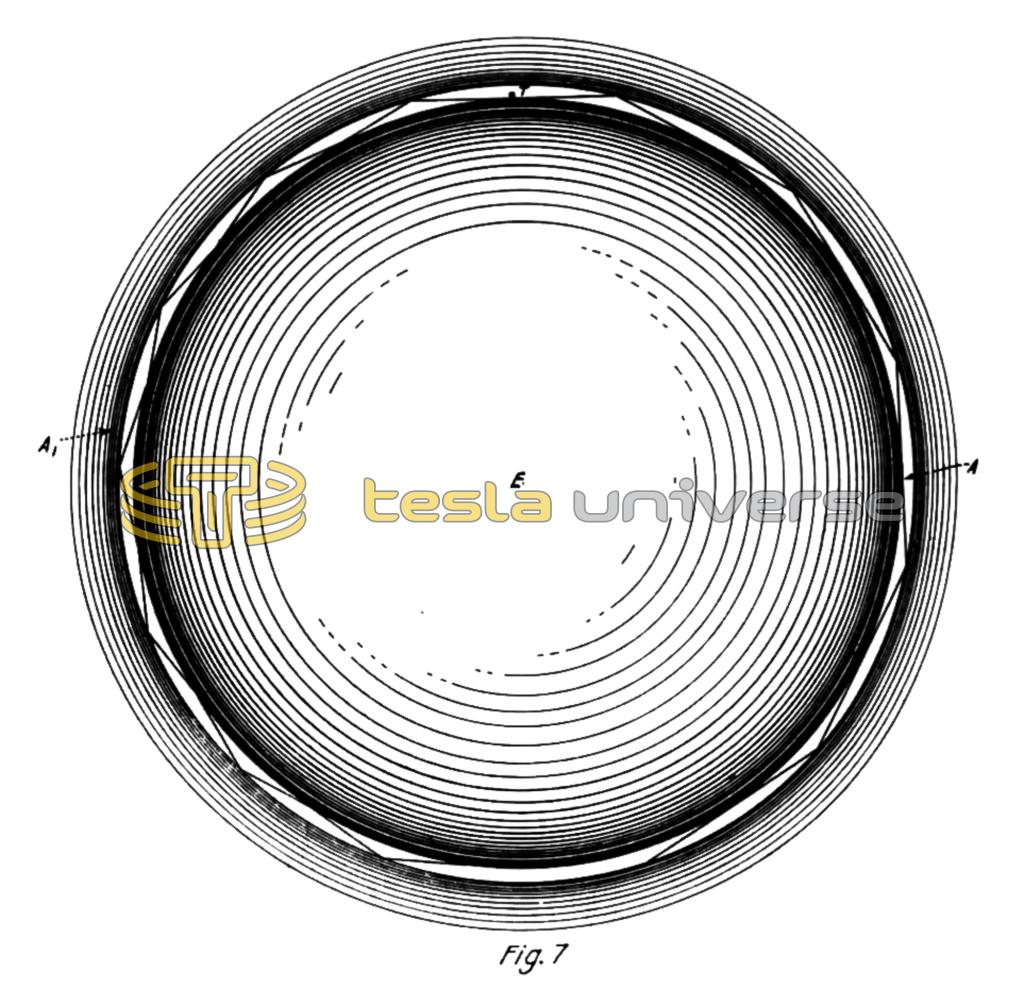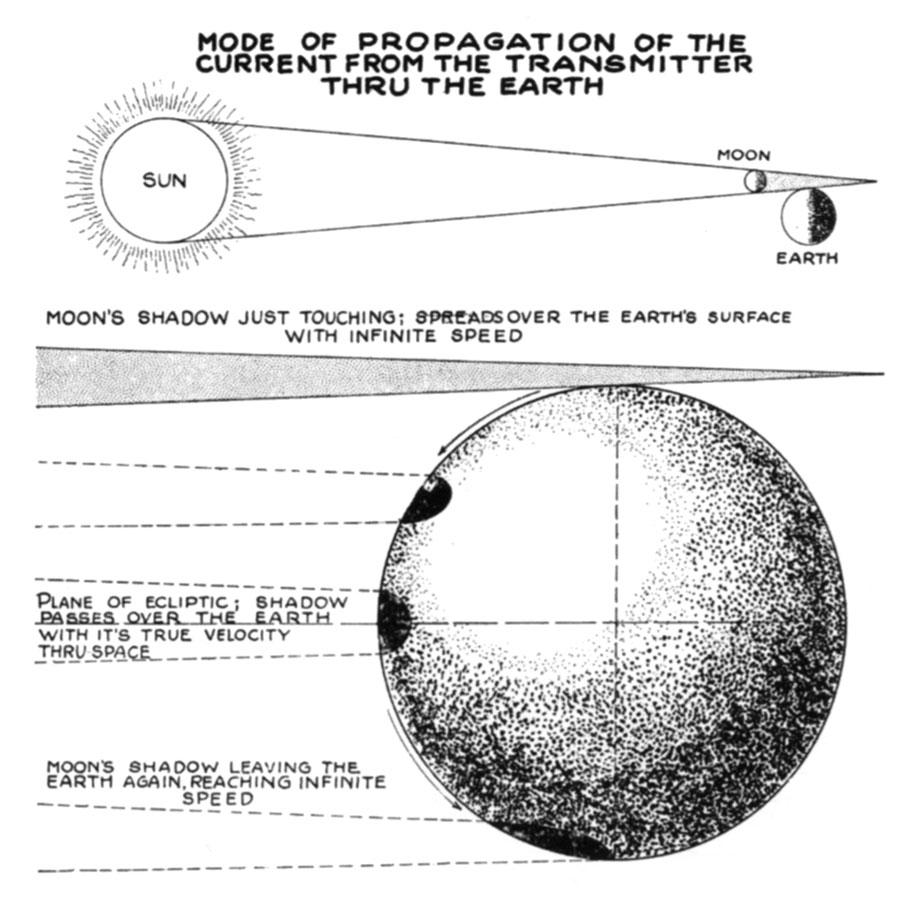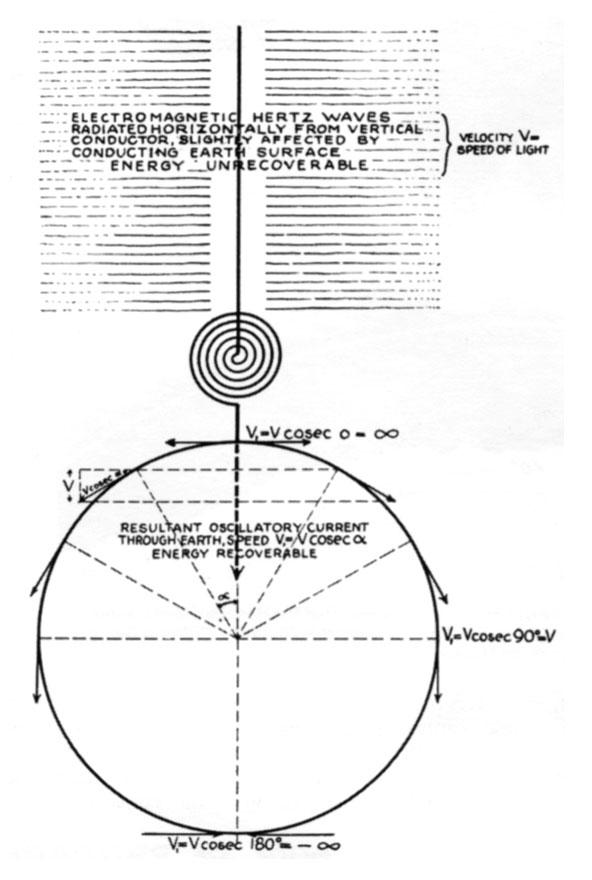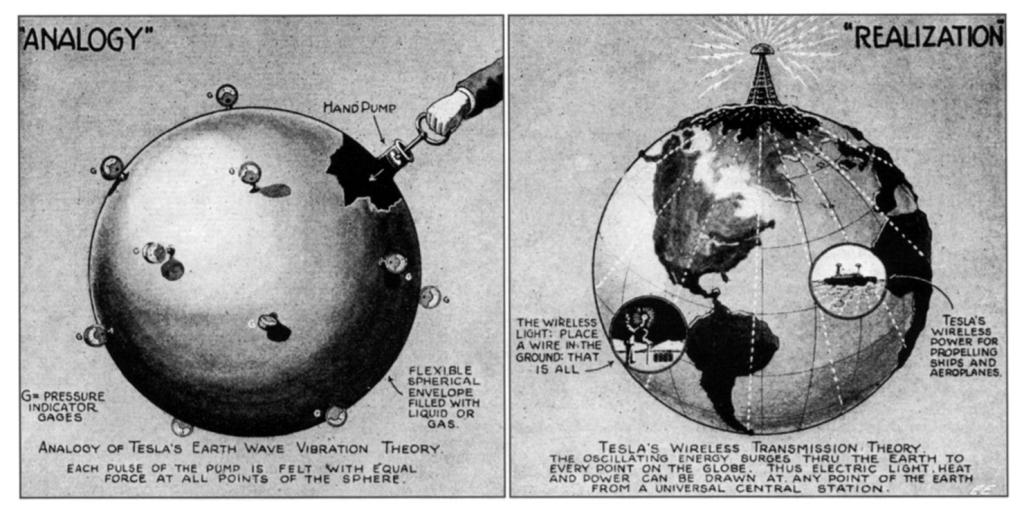
Nikola Tesla Articles
Famous Scientific Illusions
Written specially for the Electrical Experimenter
Preface #1:
For over a century and a half the whole world, educated and otherwise, thought that the moon revolved around its axis. Nikola Tesla in the present highly instructive article disproves that theory and will convince scientists and all others alike that the moon does so such thing.
For thousands of years it was thought that the sun and stars revolved around the earth and all kinds of experimental proofs were furnished to substantiate this theory. The illustrious Galileo thought different, and everyone today knows that the earth revolves around the sun.
So it is with Tesla’s discovery. Tesla also, in the second part of the present paper, shows us that the ancient and time-worn theory advanced by Benjamin Franklin as to the lightning conductor is not substantially correct as viewed by latter day science. It will come as a shock even to our professors that the lightning rod actually aids the lightning in hitting the building. The reason is that the lightning rod helps in ionizing (making conductive) the surrounding air.
Mr. Tesla has devised a lightning conductor with no points, and there is no doubt whatsoever that his theory is right. Scientists the world over will acknowledge this very shortly.
In a third section of the same paper Tesla explodes still another popular delusion, viz., that wireless waves follow the curvature of the earth when messages are transmitted, let us say from a point in the United States to a point in Europe. In his revolutionary arguments, supported by facts as well as by logic, Tesla shows why the currents do not travel around the earth but directly thru it. In other words, Tesla maintains that wireless communication is accomplished ONLY thru the medium of the earth itself. His contention seems very sound. If it were not so, let every wireless station, commercial or otherwise, do away with its ground connection. None could then operate as is well known, except perhaps over very limited distances.
Mr. Tesla’s present article will arouse world-wide comment due to the revolutionary philosophy contained therein. We are sure our readers will appreciate Mr. Tesla’s most timely and illuminating article on this but little understood subject.
Preface #2:
In this original and revolutionizing discussion, Nikola Tesla given us something really new to think about. First — Does the moon rotate on its axis? Second — is the Franklin pointed lightning rod correct in theory and operation? Third — Do wireless signal fly thru space by means of so-called Hertzian waves in the ether, or are they propagated thru the earth at prodigious velocity by means of earth-bound oscillations? World-famous conundrums these — questions which have been answered in many ways by some of the greatest scientists. Dr. Tesla explains these three predominant scientific fallacies in a masterly way, so that everyone can understand them.
Article:
The human brain, with all its wonderful capabilities and power, is far from being a faultless apparatus. Most of its parts may be in perfect working order, but some are atrophied, undeveloped or missing altogether. Great men of all classes and professions — scientists, inventors, and hard-headed financiers — have placed themselves on record with impossible theories, inoperative devices, and unrealizable schemes. It is doubtful that there could be found a single work of any one individual free of error. There is no such thing as an infallible brain. Invariably, some cells or fibers are wanting or unresponsive, with the result of impairing judgment, sense of proportion, or some other faculty. A man of genius eminently practical, whose name is a household word, has wasted the best years of his life in a visionary undertaking. A celebrated physicist was incapable of tracing the direction of an electric current according to a childishly simple rule. The writer, who was known to recite entire volumes by heart, has never been able to retain in memory and recapitulate in their proper order the words designating the colors of the rainbow, and can only ascertain them after long and laborious thought, strange as it may seem.
Our organs of reception, too, are deficient and deceptive. As a semblance of life is produced by a rapid succession of inanimate pictures, so many of our perceptions are but trickery of the senses, devoid of reality. The greatest triumphs of man were those in which his mind had to free itself from the influence of delusive appearances. Such was the revelation of Buddha that self is an illusion caused by the persistence and continuity of mental images: the discovery of Copernicus that, contrary to all observation, this planet rotates around the sun; the recognition of Descartes that the human being is an automaton, governed by external influence and the idea that the earth is spherical, which led Columbus to the finding of this continent. And tho the minds of individuals supplement one another and science and experience are continually eliminating fallacies and misconceptions, much of our present knowledge is still incomplete and unreliable. We have sophisms in mathematics which cannot be disproved. Even in pure reasoning, free of the shortcomings of symbolic processes, we are often arrested by doubt which the strongest intelligences have been unable to dispel. Experimental science itself, most positive of all, is not unfailing.
In the following I shall consider three exceptionally interesting errors in the interpretation and application of physical phenomena which have for years dominated the minds of experts and men of science.
I. The Illusion of the Axial Rotation of the Moon.
It is well known since the discovery of Galileo that the moon, in travelling thru space, always turns the same face towards the earth. This is explained by stating that while passing once around its mother-planet the lunar globe performs just one revolution on its axis. The spinning motion of a heavenly body must necessarily undergo modifications in the course of time, being either retarded by resistances internal or external, or accelerated owing to shrinkage and other causes. An unalterable rotational velocity thru all phases of planetary evolution is manifestly impossible. What wonder, then, that at this very instant of its long existence our satellite should revolve exactly so, and not faster or slower. But many astronomers have accepted as a physical fact that such rotation takes place. It does not, but only appears so; it is an illusion, a most surprising one, too.
I will endeavor to make this clear by reference to Fig. 1, in which E represents the earth and M the moon. The movement thru space is such that the arrow, firmly attached to the latter, always occupies the position indicated with reference to the earth. If one imagines himself as looking down on the orbital plane and follows the motion he will become convinced that the moon does turn on its axis as it travels around. But in this very act the observer will have deceived himself. To make the delusion complete let him take a washer similarly marked and supporting it rotatably in the center, carry it around a stationary object, constantly keeping the arrow pointing towards the latter. Tho to his bodily vision the disk will revolve on its axis, such movement does not exist. He can dispel the illusion at once by holding the washer fixedly while going around. He will now readily see that the supposed axial rotation is only apparent, the impression being produced by successive changes of position in space.
But more convincing proofs can be given that the moon does not, and cannot revolve on its axis. With this object in view attention is called to Fig. 2, in which both the satellite, M, and earth, E, are shown embedded in a solid mass, M1, (indicated by stippling) and supposed to rotate so as to impact to the moon its normal translatory velocity. Evidently, if the lunar globe could rotate as commonly believed, this would be equally true of any other portion of mass M1, as the sphere M2, shown in dotted lines, and then the part common to both bodies would have to turn simultaneously in opposite directions. This can be experimentally illustrated in the manner suggested by using instead of one, two overlapping rotatable washers, as may be conveniently represented by circles M and M2, and carrying them around a center as E, so that the plain and dotted arrows are always pointing towards the same center. No further argument is needed to demonstrate that the two gyrations cannot co-exist or even be pictured in the imagination and reconciled in a purely abstract sense.
The truth is, the so-called “axial rotation” of the moon is a phenomenon deceptive alike to the eye and mind and devoid of physical meaning. It has nothing in common with real mass revolution characterized by effects positive and unmistakable. Volumes have been written on the subject and many erroneous arguments advanced in support of the notion. Thus, it is reasoned, that if the planet did not turn on its axis it would expose the whole surface to terrestrial view; as only one-half is visible, it must revolve. The first statement is true but the logic of the second is defective, for it admits of only one alternative. The conclusion is not justified as the same appearance can also be produced in another way. The moon does rotate, not on its own, but about an axis passing thru the center of the earth, the true and only one.
The unfailing test of the spinning of a mass is, however, the existence of energy of motion. The moon is not possest of such vis viva. If it were the case then a revolving body as M1 would contain mechanical energy other than that of which we have experimental evidence. Irrespective of this so exact a coincidence between the axial and orbital periods is, in itself, immensely improbable for this is not the permanent condition towards which the system is tending. Any axial rotation of a mass left to itself, retarded by forces external or internal, must cease. Even admitting its perfect control by tides the coincidence would still be miraculous. But when we remember that most of the satellites exhibit this peculiarity, the probability becomes infinitestimal.
Three theories have been advanced for the origin of the moon. According to the oldest suggested by the great German philosopher Kant, and developed by Laplace in his monumental treatise “Mécanique Céleste,” the planets have been thrown off from larger central masses by centrifugal force. Nearly forty years ago Prof. George H. Darwin in a masterful essay on tidal friction furnished mathematical proofs, deemed unrefutable, that the moon had separated from the earth. Recently this established theory has been attacked by Prof. T. J. J. See in a remarkable work on the “Evolution of the Stellar Systems,” in which he propounds the view that centrifugal force was altogether inadequate to bring about the separation and that all planets, including the moon, have come from the depths of space and have been captured. Still a third hypothesis of unknown origin exists which has been examined and commented upon by Prof. W. H. Pickering in “Popular Astronomy of 1907,” and according to which the moon was torn from the earth when the later was partially solidified, this accounting for the continents which might not have been formed otherwise.
Undoubtedly planets and satellites have originated in both ways and, in my opinion, it is not difficult to ascertain the character of their birth. The following conclusions can be safely drawn:
1. A heavenly body thrown off from a larger one cannot rotate on its axis. The mass, rendered fluid by the combined action of heat and pressure, upon the reduction of the latter immediately stiffens, being at the same time deformed by gravitational pull. The shape becomes permanent upon cooling and solidification and the smaller mass continues to move about the larger one as tho it were rigidly connected to it except for pendular swings or librations due to varying orbital velocity. Such motion precludes the possibility of axial rotation in the strictly physical sense. The moon has never spun around as is well demonstrated by the fact that the most precise measurements have failed to show any measurable flattening in form.
2. If a planetary body in its orbital movement turns the same side towards the central mass this is a positive proof that it has been separated from the latter and is a true satellite.
3. A planet revolving on its axis in its passage around another cannot have been thrown off from the same but must have been captured.
II. The Fallacy of Franklin’s Pointed Lightning-Rod.
The display of atmospheric electricity has since ages been one of the most marvelous spectacles afforded to the sight of man. Its grandeur and power filled him with fear and superstition. For centuries he attributed lightning to agents god-like and supernatural and its purpose in the scheme of this universe remained unknown to him. Now we have learned that the waters of the ocean are raised by the sun and maintained in the atmosphere delicately suspended, that they are wafted to distant regions of the globe where electric forces assert themselves in upsetting the sensitive balance and causing precipitation, thus sustaining all organic life. There is every reason to hope that man will soon be able to control this life-giving flow of water and thereby solve many pressing problems of his existence.
Atmospheric electricity became of special scientific interest in Franklin’s time. Faraday had not yet announced his epochal discoveries in magnetic induction but static frictional machines were already generally used in physical laboratories. Franklin’s powerful mind at once leaped to the conclusion that frictional and atmospheric electricity were identical. To our present view this inference appears obvious, but in his time the mere thought of it was little short of blasphemy. He investigated the phenomena and argued that if they were of the same nature then the clouds could be drained of their charge exactly as the ball of a static machine, and in 1749 he indicated in a publisht memoir how this could be done by the use of pointed metal rods.
The earliest trials were made by Dalibrand in France, but Franklin himself was the first to obtain a spark by using a kite, in June, 1752. When these atmospheric discharges manifest themselves today in our wireless station we feel annoyed and wish that they would stop, but to the man who discovered them they brought tears of joy.
The lightning conductor in its classical form was invented by Benjamin Franklin in 1755 and immediately upon its adoption proved a success to a degree. As usual, however, its virtues were often exaggerated. So, for instance, it was seriously claimed that in the city of Pietermaritzburg (capital of Natal, South Africa) no lightning strokes occurred after the pointed rods were installed, altho the storms were as frequent as before. Experience has shown that just the opposite is true. A modern city like New York, presenting innumerable sharp points and projections in good contact with the earth, is struck much more often than equivalent area of land. Statistical records, carefully compiled and publisht from time to time, demonstrate that the danger from lightning to property and life has been reduced to a small percentage by Franklin’s invention, but the damage by fire amounts, nevertheless, to several million dollars annually. It is astonishing that this device, which has been in universal use for more than one century and a half, should be found to involve a gross fallacy in design and construction which impairs its usefulness and may even render its employment hazardous under certain conditions.
For explanation of this curious fact I may first refer to Fig. 3, in which s is a metallic sphere of radius r, such as the capacity terminal of a static machine, provided with a sharply pointed pin of length h, as indicated. It is well known that the latter has the property of quickly dissipating the accumulated charge into the air. To examine this action in the light of present knowledge we may liken electric potential to temperature. Imagine that sphere s is heated to T degrees and that the pin or metal bar is a perfect conductor of heat so that its extreme end is at the same temperature T. Then if another sphere of larger radius, v1, is drawn about the first and the temperature along this boundary is T1, it is evident that there will be between the end of the bar and its surrounding a difference of temperature T — T1, which will determine the outflow of heat. Obviously, if the adjacent medium was not affected by the hot sphere this temperature difference would be greater and more heat would be given off. Exactly so in the electric system. Let q be the quantity of the charge, then the sphere — and owing to its great conductivity also the pin — will be at the potential q / r. The medium around the point of the pin will be at the potential q / r1 = q / (r + h) and, consequently, the difference q / r — q / (r + h) = q h / r (r + h). Suppose now that a sphere S of much larger radius R = nr is employed containing a charge Q this difference of potential will be, analogously Qh / R (R + h). According to elementary principles of electro-statics the potentials of the two spheres s and S will be equal if Q = nq in which case Qh / R (R + h) = nqh / nr (nr + h) = qh / r (nr + h). Thus the difference of potential between the point of the pin and the medium around the same will be smaller in the ratio r + h / nr + h when the large sphere is used. In many scientific tests and experiments this important observation has been disregarded with the result of causing serious errors. Its significance is that the behavior of the pointed rod entirely depends on the linear dimensions of the electrified body. Its quality to give off the charge may be entirely lost if the latter is very large. For this reason, all points or projections on the surface of a conductor of such vast dimensions as the earth would be quite ineffective were it not for other influences. These will be elucidated with reference to Fig. 4, in which our artist of the Impressionist school has emphasized Franklin’s notion that his rod was drawing electricity from the clouds. If the earth were not surrounded by an atmosphere which is generally oppositely charged it would behave, despite all its irregularities of surface, like a polished sphere. But owing to the electrified masses of air and cloud the distribution is greatly modified. Thus in Fig. 4, the positive charge of the cloud induces in the earth an equivalent opposite charge, the density at the surface of the latter diminishing with the cube of the distance from the static center of the cloud. A brush discharge is then formed at the point of the rod and the action Franklin anticipated takes place. In addition, the surrounding air is ionized and rendered conducting and, eventually, a bolt may hit the building or some other object in the vicinity. The virtue of the pointed end to dissipate the charge, which was uppermost in Franklin’s mind is, however, infinitesimal. Careful measurements show that it would take many years before the electricity stored in a single cloud of moderate size would be drawn off or neutralized thru such a lightning conductor. The grounded rod has the quality of rendering harmless most of the strokes it receives, tho occasionally the charge is diverted with damaging results. But, what is very important to note, it invites danger and hazard on account of the fallacy involved in its design. The sharp point which was thought advantageous and indispensable to its operation, is really a defect detracting considerably from the practical value of the device. I have produced a much improved form of lightning protector characterized by the employment of a terminal of considerable area and large radius of curvature which makes impossible undue density of the charge and ionization of the air.* These protectors act as quasi-repellents and so far have never been struck tho exposed a long time. Their safety is experimentally demonstrated to greatly exceed that invented by Franklin. By their use property worth millions of dollars which is now annually lost, can be saved.
* Refer to the October, 1918, issue of this journal wherein Dr. Tesla’s new form of non-pointed lightning rod was fully described and illustrated.
III. The Singular Misconception of the Wireless.
To the popular mind this sensational advance conveys the impression of a single invention but in reality it is an art, the successful practise of which involves the employment of a great many discoveries and improvements. I viewed it as such when I undertook to solve wireless problems and it is due to this fact that my insight into its underlying principles was clear from their very inception.
In the course of development of my induction motors it became desirable to operate them at high speeds and for this purpose I constructed alternators of relatively high frequencies. The striking behavior of the currents soon captivated my attention and in 1889 I started a systematic investigation of their properties and the possibilities of practical application. The first gratifying result of my efforts in this direction was the transmission of electrical energy thru one wire without return, of which I gave demonstrations in my lectures and addresses before several scientific bodies here and abroad in 1891 and 1892. During that period, while working with my oscillation transformers and dynamos of frequencies up to 200,000 cycles per second, the idea gradually took hold of me that the earth might be used in place of the wire, thus dispensing with artificial conductors altogether. The immensity of the globe seemed an unsurmountable obstacle but after a prolonged study of the subject I became satisfied that the undertaking was rational, and in my lectures before the Franklin Institute and National Electric Light Association early in 1893 I gave the outline of the system I had conceived. In the latter part of that year, at the Chicago World’s Fair, I had the good fortune of meeting Prof. Helmholtz to whom I explained my plan, illustrating it with experiments. On that occasion I asked the celebrated physicist for an expression of opinion on the feasibility of the scheme. He stated unhesitatingly that it was practicable, provided I could perfect apparatus capable of putting it into effect but this, he anticipated, would be extremely difficult to accomplish.
I resumed the work very much encouraged and from that date to 1896 advanced slowly but steadily, making a number of improvements the chief of which was my system of concatenated tuned circuits and method of regulation, now universally adopted. In the summer of 1897 Lord Kelvin happened to pass thru New York and honored me by a visit to my laboratory where I entertained him with demonstrations in support of my wireless theory. He was fairly carried away with what he saw but, nevertheless, condemned my project in emphatic terms, qualifying it as something impossible, “an illusion and a snare.” I had expected his approval and was pained and surprised. But the next day he returned and gave me a better opportunity for explanation of the advances I had made and of the true principles underlying the system I had evolved. Suddenly he remarked with evident astonishment: “Then you are not making use of Hertz waves?” “Certainly not,” I replied, “these are radiations. No energy could be economically transmitted to a distance by any such agency. In my system the process is one of true conduction which, theoretically, can be effected at the greatest distance without appreciable loss.” I can never forget the magic change that came over the illustrious philosopher the moment he freed himself from that erroneous impression. The skeptic who would not believe was suddenly transformed into the warmest of supporters. He parted from me not only thoroly convinced of the scientific soundness of the idea but strongly exprest his confidence in its success. In my exposition to him I resorted to the following mechanical analogues of my own and the Hertz wave system.
Imagine the earth to be a bag of rubber filled with water, a small quantity of which is periodically forced in and out of the same by means of a reciprocating pump, as illustrated. If the strokes of the latter are effected in intervals of more than one hour and forty-eight minutes, sufficient for the transmission of the impulse thru the whole mass, the entire bag will expand and contract and corresponding movements will be imparted to pressure gauges or movable pistons with the same intensity, irrespective of distance. By working the pump faster, shorter waves will be produced which, on reaching the opposite end of the bag, may be reflected and give rise to stationary nodes and loops, but in any case, the fluid being incompressible, its inclosure perfectly elastic, and the frequency of oscillations not very high, the energy will be economically transmitted and very little power consumed so long as no work is done in the receivers. This is a crude but correct representation of my wireless system in which, however, I resort to various refinements. Thus, for instance, the pump is made part of a resonant system of great inertia, enormously magnifying the force of the imprest impulses. The receiving devices are similarly conditioned and in this manner the amount of energy collected in them vastly increased.
The Hertz wave system is in many respects the very opposite of this. To explain it by analogy, the piston of the pump is assumed to vibrate to and fro at a terrific rate and the orifice thru which the fluid passes in and out of the cylinder is reduced to a small hole. There is scarcely any movement of the fluid and almost the whole work performed results in the production of radiant heat, of which an infinitesimal part is recovered in a remote locality. However incredible, it is true that the minds of some of the ablest experts have been from the beginning, and still are, obsest by this monstrous idea, and so it comes that the true wireless art, to which I laid the foundation in 1893, has been retarded in its development for twenty years. This is the reason why the “statics” have proved unconquerable, why the wireless shares are of little value and why the Government has been compelled to interfere.
We are living on a planet of well-nigh inconceivable dimensions, surrounded by a layer of insulating air above which is a rarefied and conducting atmosphere (Fig. 5). This is providential, for if all the air were conducting the transmission of electrical energy thru the natural media would be impossible. My early experiments have shown that currents of high frequency and great tension readily pass thru an atmosphere but moderately rarefied, so that the insulating stratum is reduced to a small thickness as will be evident by inspection of Fig. 6, in which a part of the earth and its gaseous envelope is shown to scale. If the radius of the sphere is 12½”, then the non-conducting layer is only 1/64″ thick and it will be obvious that the Hertzian rays cannot traverse so thin a crack between two conducting surfaces for any considerable distance, without being absorbed. The theory has been seriously advanced that these radiations pass around the globe by successive reflections, but to show the absurdity of this suggestion reference is made to Fig. 7 in which this process is diagrammatically indicated. Assuming that there is no refraction, the rays, as shown on the right, would travel along the sides of a polygon drawn around the solid, and inscribed into the conducting gaseous boundary in which case the length of the side would be about 400 miles. As one-half the circumference of the earth is approximately 12,000 miles long there will be, roughly, thirty deviations. The efficiency of such a reflector cannot be more than 25 per cent, so that if none of the energy of the transmitter were lost in other ways, the part recovered would be measured by the fraction (¼)30. Let the transmitter radiate Hertz waves at the rate of 1,000 kilowatts. Then about one hundred and fifteen billionth part of one watt is all that would be collected in a perfect receiver. In truth, the reflections would be much more numerous as shown on the left of the figure, and owing to this and other reasons, on which it is unnecessary to dwell, the amount recovered would be a vanishing quantity.
Consider now the process taking place in the transmission by the instrumentalities and methods of my invention. For this purpose attention is called to Fig. 8, which gives an idea of the mode of propagation of the current waves and is largely self-explanatory. The drawing represents a solar eclipse with the shadow of the moon just touching the surface of the earth at a point where the transmitter is located. As the shadow moves downward it will spread over the earth’s surface, first with infinite and then gradually diminishing velocity until at a distance of about 6,000 miles it will attain its true speed in space. From there on it will proceed with increasing velocity, reaching infinite value at the opposite point of the globe. It hardly need be stated that this is merely an illustration and not an accurate representation in the astronomical sense.
The exact law will be readily understood by reference to Fig. 9, in which a transmitting circuit is shown connected to earth and to an antenna. The transmitter being in action, two effects are produced: Hertz waves pass thru the air, and a current traverses the earth. The former propagate with the speed of light and their energy is unrecoverable in the circuit. The latter proceeds with the speed varying as the cosecant of the angle which a radius drawn from any point under consideration forms with the axis of symmetry of the waves. At the origin the speed is infinite but gradually diminishes until a quadrant is traversed, when the velocity is that of light. From there on it again increases, becoming infinite at the antipole. Theoretically the energy of this current is recoverable in its entirety, in properly attuned receivers.
Some experts, whom I have credited with better knowledge, have for years contended that my proposals to transmit power without wires are sheer nonsense but I note that they are growing more cautious every day. The latest objection to my system is found in the cheapness of gasoline. These men labor under the impression that the energy flows in all directions and that, therefore, only a minute amount can be recovered in any individual receiver. But this is far from being so. The power is conveyed in only one direction, from the transmitter to the receiver, and none of it is lost elsewhere. It is perfectly practicable to recover at any point of the globe energy enough for driving an airplane, or a pleasure boat or for lighting a dwelling. I am especially sanguine in regard to the lighting of isolated places and believe that a more economical and convenient method can hardly be devised. The future will show whether my foresight is as accurate now as it has proved heretofore.
